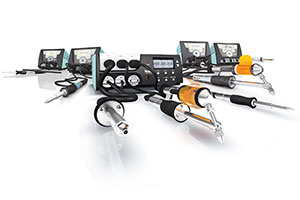Ulf Timmermann, CEO of reichelt elektronik, discusses five electronics inventions which have changed the landscape of modern life…
50 years ago, a computer was still the size of a room and a team of people were required to make it work. Now, we have an array of electronic inventions at our fingertips, from smart sensors, to LEDs, to 3D printers, all fully controllable through the power of the internet.
While some may have fallen by the wayside (anyone remember the fax machine?), some of the inventions of the last five decades have stood the test of time and are indispensable today. To celebrate reichelt’s half century of trading, we’ve taken a look back to give an overview of five pioneering inventions in electronics history.
The battery
What would the world look like without batteries? Used for powering the smallest electronics such as smartphones to something larger like an entire city, this invention was a turning point for mankind.
Invented in the 1800 by Alessandro Volta (namesake of the volts unit of measurement of course), The Voltasche Column consisted of copper and zinc flakes stacked on top of each other as well as pieces of cardboard and leather saturated with electrolyte that would then conduct the current. Unfortunately, but perhaps unsurprisingly, this early version was deemed unsafe due to the hazardous materials. 
Now, lithium-based batteries can be found in every electrical device, powering almost all innovations since its invention.
The soldering iron
A must-have for DIYers and industry alike, the soldering iron has been an essential tool for creating many objects we couldn’t live without today.
Although present-day soldering irons are mainly electrical, these devices used to be powered by heating coal and gas. The humble soldering iron can be traced back to the times of Egyptian Pharaohs and Trojan horses. Materials used for soldering included gold and silver, but tin was preferred as an inexpensive material.
Today’s electrical soldering iron was invented in 1921, with the iron perfected over time adding new features. Now it’s found in every workshop and tool-shed around the world.
The circuit board
Thanks in part to the soldering iron came an invention you almost certainly have in your pocket right now. The circuit board was developed to clean up the jumbled assortment of electronic components found in devices. Before that, all components were crossed and mixed up, making a 1930s engineer’s job that much harder.
In 1950, the circuit board really came into its own and gradually became smaller and smaller so it can be squeezed into any device. Now available to anyone, whether they’re in the electronics industry or a DIYer, they can be used for a variety of purposes. The Raspberry Pi for example, can be used as a personal cloud storage device, smart home device or for online security.
With more developments in power and continuous shrinking in size, the possibilities of circuit boards continue to be unlocked.
The digital storage oscilloscope
Electrical engineers across the globe would agree the oscilloscope is an essential tool to have in the industry.
Although it dates back to the early 20th century, the first digital storage oscilloscope was launched in the 1980s by New York-based manufacturer LeCroy.
These digital storage oscilloscopes have overtaken their analogue predecessors due to an increased set of features, speedier performance, and larger memory. Now, they are available in a variety of price ranges for both personal and professional use, and include various functions depending on the device.
The 3D printer
50 years ago, 3D printing didn’t exist. Now, it’s being used in electronics, medical technology and many other industries – not to mention all the hobbyists making products at home too. There have been many stories in the news where items and devices that are usually complex have been made using 3D printing techniques for a variety of uses. Notable examples include the making of prosthetic limbs that would usually cost substantially more than they would using a 3D printer.
The development of 3D printing began in 1981 when Hideo Kodama of Nagoya Municipal Industrial Research Institute invented two additive methods for fabricating three-dimensional plastic models. This was successfully practiced in 1983 and the first 3D printer was released in 1988 to the public.
Since then, the art and technology has evolved and been perfected with the devices readily available for use in a personal and professional environment. The evolution of the printer has made way for a growing number of the filaments, such as wood and chocolate, that can now be printed. 
What’s next for electronics?
It is difficult to predict what the electronics and components landscape will look like in another 50 years’ time, and which technologies will be indispensable to the electronics industry in the long term.
With continuous public and commercial interest in the ‘Internet of Things’, we will see many more connected devices that can be controlled remotely, from household appliances to vehicles. A more connected world also means bigger and more complex networks to link the devices together.
The fourth industrial revolution will mean everything is connected and therefore electronic. Who knows what another 50 years of technological evolution will look like? For the team here at reichelt, we can’t wait to see what comes along next.






